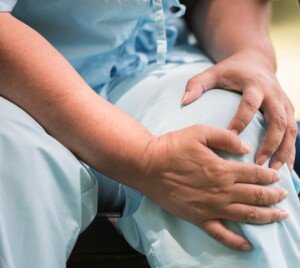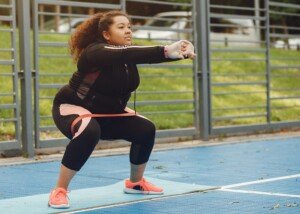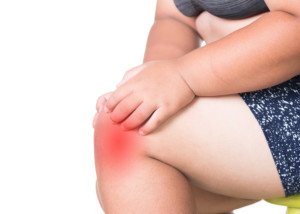Morbid obesity = unhealthy KNEES. If you think you have a healthy heart despite your obesity, then at least consider its effect on your knees. Arthritis is waiting for you.
More and more women with morbid obesity are boarding that bandwagon that proclaims that even a significant amount of excess fat does not impair one’s health.
If you’re on that bandwagon, have you ever thought about what all that weight will do to your knees over time?
You could have the lowest blood pressure, the lowest blood sugar and the lowest triglycerides in the world – and all of that STILL won’t negate what significant overweight will due to your knee joints.
The Effect of Morbid Obesity on an Inherently Unstable Joint
The knee joint is the most unstable joint in the human body – by nature – regardless of body weight.
The human knee is inherently unstable because humans became smart before their knee joint had a chance to evolve into something super sturdy and resilient.
In other words, we invented crutches, wheelchairs, cortisone injections and knee replacement surgery before the joint could evolve into something a lot stronger.
Therefore, the joint became “stuck” in the evolutionary process and to this day, remains highly susceptible to wear-and-tear and other kinds of damage.
“Morbid obesity can basically age a person’s knee by 20 years!” says Barbara Bergin, MD, an orthopedic surgeon at and co-founder of Texas Orthopedics, Sports & Rehabilitation Associates.
“So, if you are a morbidly obese, 44-year-old, your knees may be worn to the degree a 60-year-old’s knees (of normal weight) would be.
“If you are predisposed to getting arthritis for any reason (family history of knee arthritis, post-traumatic arthritis), the knee arthritis could even be worse.
“I have seen many morbidly obese 35- and 40-year-olds with advanced arthritic changes!
“But even being [moderately] overweight can cause more pressure on the knees.”
The Effectiveness of Weight Loss for Arthritic Knees
“Weight loss is a very effective, albeit difficult way to reduce the pain of knee arthritis,” says Dr. Bergin.
“Any weight loss is good for the weight-bearing joints (hips, knees, ankles and feet).
“I never say to my patients, ‘just lose weight,’ because this is one of the most difficult things to do for my overweight/obese patients to do.
“It’s a vicious cycle. Decreasing caloric intake results in a slowing of the metabolism, so weight loss can be painstakingly slow, and if you’re looking at 100 lbs. of weight loss, it can be overwhelming.
“Increasing exercise results in more wear and tear on the painful joints,” depending on the type of exercise.
“Obesity is a multi-factorial disease, which as we have seen historically, is almost impossible to treat, never mind cure.”
The Effect of Weight Loss on Knee Replacement Surgery
Dr. Bergin explains, “The second part to this question/answer, is that weight loss also improves the likelihood of a good outcome when the patient eventually decides to have their knee replaced.”
One favorable outcome is that the patient will have an easier time getting up and about after the operation – which is extremely important to prevent blood clots and acclimate the body to the new hardware.
Another benefit to presurgical weight loss is the risk reduction of dangerous blood clots.
Another complication that obesity can heighten is the chance of an adverse response to being taken off of the general anesthesia.
“Morbid obesity increases the likelihood of surgical site infection, and early loosening of the prosthesis, requiring additional surgeries and likely early revision (redoing the operation),” says Dr. Bergin.
Recovery in the weeks following will be much easier with a lighter body. Getting in and out of a car or off a toilet seat (even a modified higher one) will be a lot harder with 100 pounds of excess body weight.
“Getting older and thinner is the best solution for a successful outcome with total knee replacements,” says Dr. Bergin.
How to Lose Weight Safely and for Sure!
If you’re younger and at least 100 pounds overweight – or even moderately heavy – don’t wait till you’re 45 or 50 and dreading facing another day of knee pain – pain that’ll just get worse and worse as the cartilage between the bones in the kneecap continues to wear away.
Don’t wait till THEN to lose a hundred pounds – when your ability to do lower body exercise is impaired.
Get started NOW – even if you’re a social media influencer pushing the idea that health can come at any size.
Get started NOW – while you can still do rigorous lower body workouts with still-decent knees.
As for “getting older and thinner,” do not take this the wrong way. Certainly this does NOT mean frail thin. It means lean with a fit, trained musculoskeletal system.
• Practice portion control.
• Cut way back on processed foods like baked goods and munchies.
• Eat five to seven servings daily of any combination of fruits and vegetables.
• Avoid processed meats.
• Eat breakfast.
• Don’t “starve” yourself or take diet pills.
Below are images of some of the best upper-body fat-burning exercises with resistance.

Bench press. Shutterstock/LightField Studios

Seated overhead press. Freepik.com

Underhand pull-down. Freepik.com

Seated row. Freepik.com yanalya
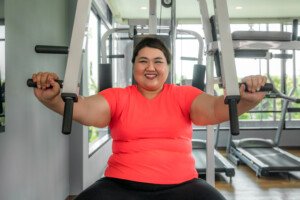
Seated chest press. Shutterstock/Travelerpix

Incline barbell press. Freepik.com
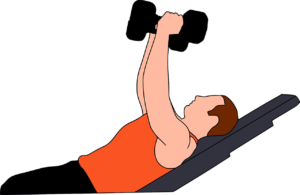
Incline dumbbell press
Finally, do interval training for cardio exercise: alternate short but rigorous segments with easier segments to catch your breath – for 30 minutes total.
If you use a treadmill, do not hold on. This is a weight loss saboteur. Here’s how to break this sabotaging habit.
What if your knees already hurt?
What if you’ve already been diagnosed with arthritis? First off, ask your doctor what aerobic exercise you CAN do.
You may get a clearance for pedaling a bike or cardio machine or walking slowly on an incline.

Don’t hold onto the treadmill because otherwise this will alter natural gait – and this can be worse for arthritic knees.
If your knees hurt when walking on a treadmill, try a pedaling machine or swimming.
Second, you most certainly can do upper body strength training, as shown in the images above.

Dr. Bergin is a general orthopedist, surgically and conservatively treating all manner of bone and joint conditions. She enjoys educating patients so they can emerge stronger than they were before their orthopedic injury or surgery.
 Lorra Garrick has been covering medical, fitness and cybersecurity topics for many years, having written thousands of articles for print magazines and websites, including as a ghostwriter. She’s also a former ACE-certified personal trainer.
Lorra Garrick has been covering medical, fitness and cybersecurity topics for many years, having written thousands of articles for print magazines and websites, including as a ghostwriter. She’s also a former ACE-certified personal trainer.
.

